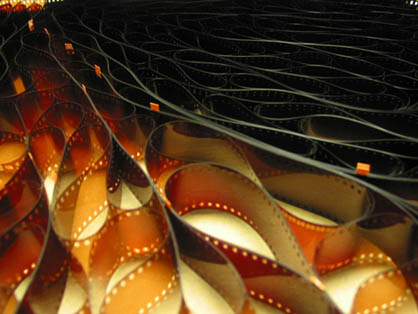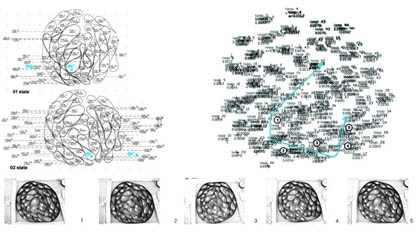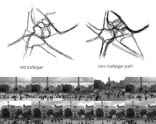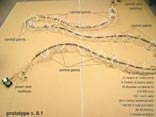|
|
||||
| home > architetture | ||||
| BASE
4. Loop.space |
||||
 Close up view of the nest-like spaces of the loop machine, a closed box in which 50 m of film is inserted. Loop.space Olympic pavilion represents an innovative solution for temporary exhibition spaces, and proposes a field of responsive looped spaces within which different types of crowds can experience the euphoria of a sporting event taking place elsewhere. The pavilion relies on spontaneous crowd congregation to propose a new radical way of perceiving a given sporting event, and each looped space is perceived as an immersive environment in which the relationship of scale and proportion between the viewer and projection are radically modified. |
[13may2006] | |||
Individual frames of the loop machine are used as the basis for mapping and analysis of the system's organizational patterns.  Quantitative analysis showing the relationship between length of strip, size and number of loops.  Diagram of the relationship between the proposed structural system and its digital control through a scripted database of node points. The concept of Bezier curve is applied to the physical model, translating the control points' weight of the digital realm in the amount of displacement (generated by DC motors) applied to specific discrete units.  Several origami-like paper model have been used to test the geometry of the discrete component and to introduce some additional structural properties to the overall looped structure.  The numerous sporting venues dispersed in the city are broadcasted collectively within the looped venue of the pavilion, enabling a large crowd congregation to enjoy several sporting events at the same time. |
 Mapping of the system as affected by a single local transformation, and mapping of its consequences at the global level.  Diagrammatic arrangement of the various functions within the cellular looped field of the pavilion according to the sports classification of the Olympic timetable.  The new landscape of the square allows for a much freer use of its surface for pedestrian circulation, and the removal of many of its existing barriers allows the pavilion to unfold during its promotional period. The pavilion is able to unfold itself as required into a network of continuous spaces which are defined by parameters of time, boundary, crowd density and program; the specific looped pattern of the pavilion represents a successful spatial organization solution which allows the structure to continuously adapt itself to any kind of boundary condition, allowing the material intelligence to maintain a constant state of dynamic equilibrium between all the parts. |
 Mapping of the crowd variance within Trafalgar Square throughout the entire year.  Pedestrian paths are traced over the existing and proposed configuration of Trafalgar Square. Crowd animations are used as a tool to re-describe the new configuration of the square in relationship to its existing and proposed uses. Mapping of the relationship between users, looped spaces, crowd types and media outputs. |
||
 The various programs offered by the pavilion structure are identified through four specific factors: type of media information applied over the loop walls, local deformation of the structure, crowd type and crowd density within each space.  Internal view of a looped space within which the spatial configuration and the media information displayed maintain the crowd in a focused and united state.  The system's components are represented by series of multifaceted polygons mounted on a continuous spline. These polygons form the pixilated wall capable of transmitting the data stream. Over each polygon either 5mm or 15 mm LED are installed (similar to the Smartslab system), allowing a perfect viewing resolution from both close and distant proximity (5000 nit cd/sqm). The locomotion of the structure is solved as an integral part of the structure, with embedded direct drive wheels within the lowest row of the pixel polygons. This would ensure the translation of the sliding friction into rolling friction and generate adequate control within the structural system. |
 View of the pavilion in Trafalgar Square, allowing groups of people to congregate in different loops according to their sporting interests. The final architectural proposal is the result of several interrelated lines of research (both physical and digital) which have been carried forward at different scales, from the individual component to the global behavior.  There are three identified structural deformations: tilting (vertical deformation), loop formation (horizontal curvature) and twisting (diagonal deformation), and each space can perform them singularly or in combination to achieve the spatial quality requested by the programme and the user. By combining together the social aspect of crowd congregation, innovative projection techniques and a dynamic continuous structure the pavilion is able to create a convincing architectural solution which could be adapted to any urban environment. Base 4 info@loopspace.com |
 The prototype in scale 1:10 is used to test the physical translation of the concept of Bezier curve and control points; a series of discrete components mounted over the continuous inner structure are able to perform fully enclosed loop spaces by means of specifically located motors.  A second prototype in scale 1:50 is developed in order to display the global deformation of the structure and the relationship of the pavilion to the feedback mechanism embedded as part of its intelligence system.  25 m of continuous trip is anchored to actuating rods, in turn connected to a series of 8 servo motors, and linked to the computer database through the Basic stamp microcontroller. By actuating each point in relation with one another a loop migration occurs, affecting the entire mass of the pavilion to move and modify its global configuration and underlying the non-linearity of the overall system. |
||
 View of the pavilion in Trafalgar Square. Base 4 (Bidisha Sinha, Andres Flores, Simone Contasta and Elena Bertarelli), was established in 2004 during the Design Research Laboratory Master Course at the Architectural Association in London; the loop.space project (thesis proposal discussed in January 2006) has has been recently awarded the First prize in the 2005 Miami Biennale Competition 'Possible futures' and a Design Merit Award at the 2005 Far Eastern International Digital Design Award. Andres Flores (Mexico 1977) is a Licensed Architect in Mexico. He founded A-flo Arquitectos in 2004; he worked for Zaha Hadid and currently he is working for Foster and Partners. Simone Contasta (Italy 1978) is a licensed architect in Italy. He has been working on several private and public projects in both Italy and UK. He is currently working for Zaha Hadid as Project Architect. Bidisha Sinha (India 1977) is an architect registered in India. Did her MArch from the DRL in responsive environments at AA, London. She currently works with Zaha Hadid Architects. Elena Bertarelli (Italy 1975) is a registered architect in Italy & the UK. Practiced in Italy before obtaining her MArch at the AA, DRL. Presently working at Foster and Partners, London. |
||||
| >
EXTENDED PLAY: YU-TUNG LIU: THE PHILOSOPHY OF DIGITAL... |
||||
| Per
candidare progetti laboratorio
|
|||||